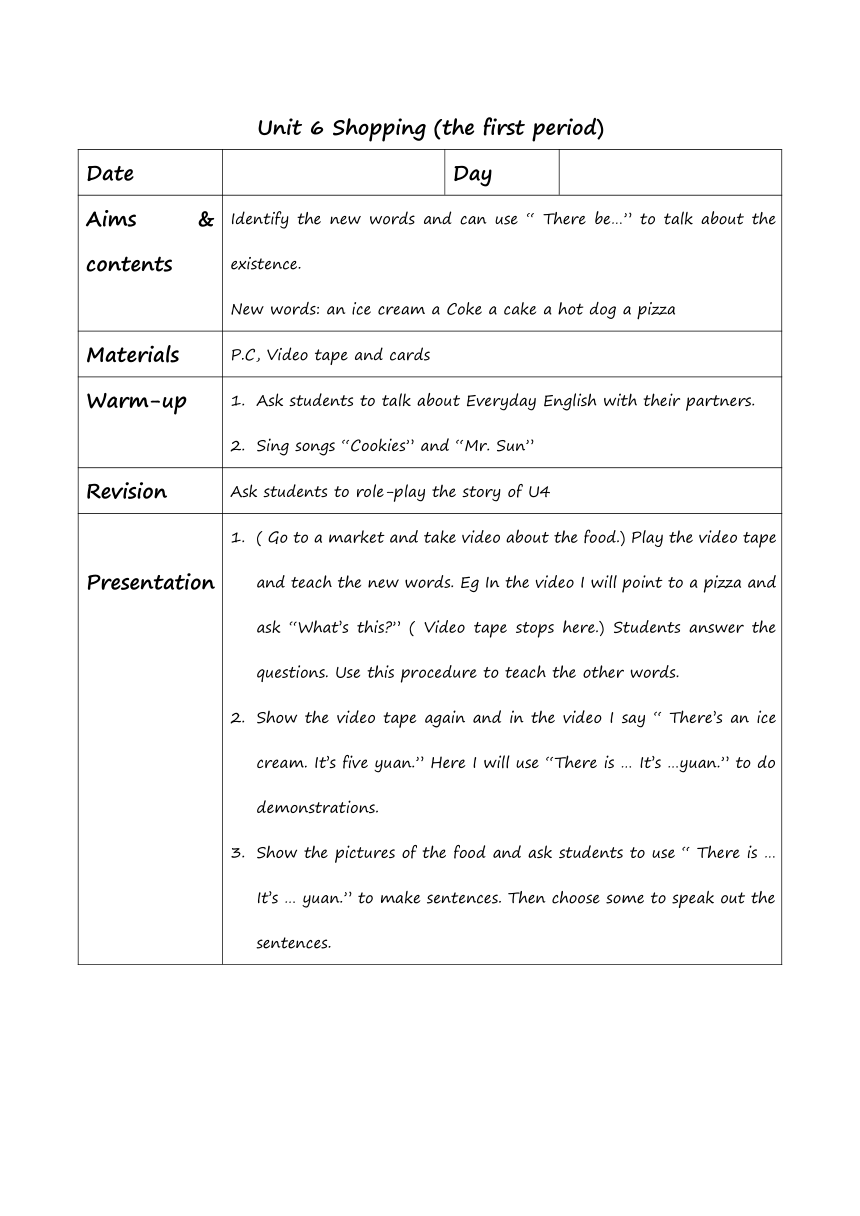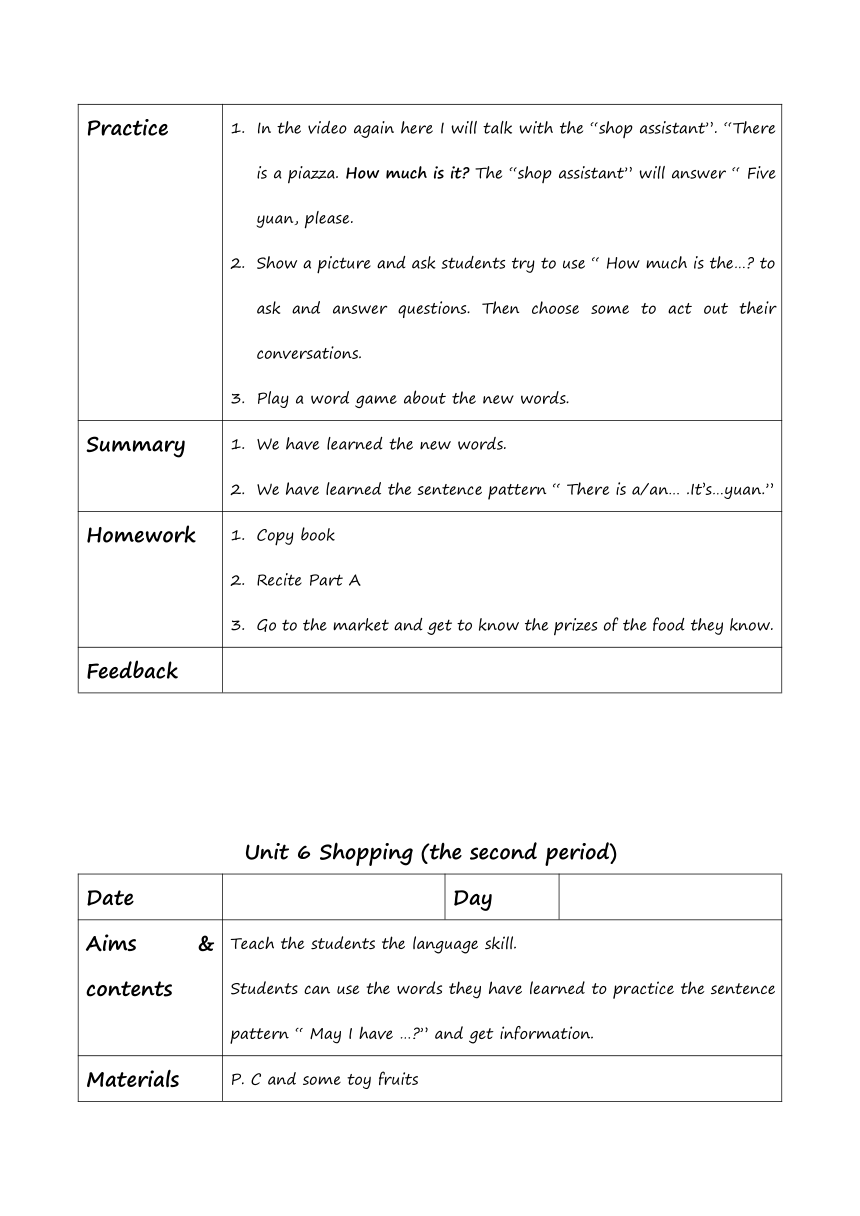Unit 6 Shopping
图片预览



文档简介
Unit 6 Shopping (the first period)DateDayAims & contentsIdentify the new words and can use “ There be…” to talk about the existence.New words: an ice cream a Coke a cake a hot dog a pizzaMaterialsP.C, Video tape and cardsWarm-upAsk students to talk about Everyday English with their partners.Sing songs “Cookies” and “Mr. Sun” RevisionAsk students to role-play the story of U4 Presentation( Go to a market and take video about the food.) Play the video tape and teach the new words. Eg In the video I will point to a pizza and ask “What’s this ” ( Video tape stops here.) Students answer the questions. Use this procedure to teach the other words.Show the video tape again and in the video I say “ There’s an ice cream. It’s five yuan.” Here I will use “There is … It’s …yuan.” to do demonstrations. Show the pictures of the food and ask students to use “ There is … It’s … yuan.” to make sentences. Then choose some to speak out the sentences.PracticeIn the video again here I will talk with the “shop assistant”. “There is a piazza. How much is it The “shop assistant” will answer “ Five yuan, please.Show a picture and ask students try to use “ How much is the… to ask and answer questions. Then choose some to act out their conversations.Play a word game about the new words.SummaryWe have learned the new words.We have learned the sentence pattern “ There is a/an… .It’s…yuan.”HomeworkCopy book Recite Part AGo to the market and get to know the prizes of the food they know. Feedback
Unit 6 Shopping (the second period)DateDayAims & contentsTeach the students the language skill.Students can use the words they have learned to practice the sentence pattern “ May I have … ” and get information.MaterialsP. C and some toy fruitsWarm-upSing songs about foodPractice Everyday English with partners.RevisionShow a picture and ask students to use “There is a/an …. It’s …yuan.”to make sentences.PresentationShow the story and ask students to look at it carefully and pay special attention to “May I have… This sentence pattern.Write “May I have… ” on board and explain the usage and give more examples, eg. May I come Then ask students to use May I have… to make sentences.3. Ask students to finish the conversations about the other two pictures.4. Ask students to role-play the story.PracticeThen some will role-play the story out.Ask students to make conversation according to the pictures with partners and write the conversation on exercise-books.Show a story and ask students to look and listen careful and then answer the questions.SummaryCan use “May I have to… ”to get information.Can understand the meaning of a simple story.HomeworkWorkbookRecite Part B Prepare for Part CFeedback
Unit 6 Shopping (the third period)DateDayAims & contentsStudents get to know the simple conversations in shopping.Students can recite and role-play the story.MaterialsPCWarm-upSing songsPractice Everyday English with partners.RevisionA game to review the words and the sentences.Students use the sentence patterns I give to make conversation.PresentationShow the story of Part C and ask students to look and listen carefully.After listening to the story and try to finish the exercise in page 31.Read the story.Mime the conversation. ( five person)PracticeAct out the story.Do the listening parts of the workbook.SummaryStudents get to know the story.Can finish some exercises.HomeworkWorkbookRecite Part CFeedback
Unit 6 Shopping (the fourth period)DateDayAims & contentsStudents use the words and the sentence patterns freely to get information.Students can pronounce the pronunciation of “th” correctly.Students can write a song by themselves.MaterialsPCWarm-upSing songs2. Practice Everyday English with partners.RevisionRecite Part CUse “ May I have… ” to practice the conversation.PresentationListen to the pronunciation of “th” and try to imitate the sound.Listen to the words and imitate the pronunciation.Listen to the poem and read it.Teach more words which have the same sound. “ three, thank”PracticeListen to the song and try to sing it.Use “three cakes, four ice creams” to write a poem by the students themselves.Choose some to read their poems.Ask students to turn to Page33, and have a conversation with partners with a group of 4.Invite some groups to act out their conversation.Reading and listening. Look and listen to a story and try to answer the questions.SummaryLearn the sound of “th”.Try to write a poem by yourselves.HomeworkCopybookWorkbookWrite a poem about food.Feedback
Unit 6 Shopping (the second period)DateDayAims & contentsTeach the students the language skill.Students can use the words they have learned to practice the sentence pattern “ May I have … ” and get information.MaterialsP. C and some toy fruitsWarm-upSing songs about foodPractice Everyday English with partners.RevisionShow a picture and ask students to use “There is a/an …. It’s …yuan.”to make sentences.PresentationShow the story and ask students to look at it carefully and pay special attention to “May I have… This sentence pattern.Write “May I have… ” on board and explain the usage and give more examples, eg. May I come Then ask students to use May I have… to make sentences.3. Ask students to finish the conversations about the other two pictures.4. Ask students to role-play the story.PracticeThen some will role-play the story out.Ask students to make conversation according to the pictures with partners and write the conversation on exercise-books.Show a story and ask students to look and listen careful and then answer the questions.SummaryCan use “May I have to… ”to get information.Can understand the meaning of a simple story.HomeworkWorkbookRecite Part B Prepare for Part CFeedback
Unit 6 Shopping (the third period)DateDayAims & contentsStudents get to know the simple conversations in shopping.Students can recite and role-play the story.MaterialsPCWarm-upSing songsPractice Everyday English with partners.RevisionA game to review the words and the sentences.Students use the sentence patterns I give to make conversation.PresentationShow the story of Part C and ask students to look and listen carefully.After listening to the story and try to finish the exercise in page 31.Read the story.Mime the conversation. ( five person)PracticeAct out the story.Do the listening parts of the workbook.SummaryStudents get to know the story.Can finish some exercises.HomeworkWorkbookRecite Part CFeedback
Unit 6 Shopping (the fourth period)DateDayAims & contentsStudents use the words and the sentence patterns freely to get information.Students can pronounce the pronunciation of “th” correctly.Students can write a song by themselves.MaterialsPCWarm-upSing songs2. Practice Everyday English with partners.RevisionRecite Part CUse “ May I have… ” to practice the conversation.PresentationListen to the pronunciation of “th” and try to imitate the sound.Listen to the words and imitate the pronunciation.Listen to the poem and read it.Teach more words which have the same sound. “ three, thank”PracticeListen to the song and try to sing it.Use “three cakes, four ice creams” to write a poem by the students themselves.Choose some to read their poems.Ask students to turn to Page33, and have a conversation with partners with a group of 4.Invite some groups to act out their conversation.Reading and listening. Look and listen to a story and try to answer the questions.SummaryLearn the sound of “th”.Try to write a poem by yourselves.HomeworkCopybookWorkbookWrite a poem about food.Feedback
